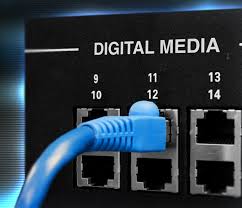With 4K video, you can have exceptional beauty and resolution. However, it also has its pitfalls and challenges. 4K is the term used to describe a video resolution that has at least 4,000 horizontal pixels. There are a number of different 4K resolutions. A common one is 4096 x 2160, which results in a total resolution of 8,847,360 pixels, which is over four times the resolution of current 1080p.
It was the move to digital cinema that brought with it a need for higher-resolution video cameras and projectors. It also brought with it a spec to help ensure that content creators, distributors and exhibitors are all on the same page, quality-wise.
You may want to display the latest high-definition and 4K sources in your boardrooms, conference rooms, classrooms, lobbies, and homes. You may also want to integrate digital and analogue AV signals together with streaming, all on one platform.
Five challenges you may face with 4K systems:
An enormous bandwidth of 10 Gbit/s is required to deliver 4K video. This puts an unprecedented demand on infrastructure. 4K distribution systems must be designed and engineered to address the following five challenges:
Mismatched resolutions
New frame rate considerations
Signal integrity issues
New cable length restrictions
Source/display compatibility
In this white paper, Crestron discusses how you can conquer the challenges of 4K video distribution by using Crestron DigitalMedia. We shall now discuss each challenge in detail.

Mismatched resolutions: 4K presents the challenge of managing two different standard resolutions. This also means that there are two different aspect ratios, one for each resolution. These are given in the table below.
|
Resolution |
Aspect Ratio |
Common Name |
|
3840×2160 |
1.78:1 (16:9) |
Ultra HD |
|
4096×2160 |
1.90:1 (~17:9) |
4K DCI (Digital Cinema Initiatives) |
Many 4K cameras and source devices can be set to either of the two resolutions.
New frame rate considerations: To deliver 1920×1080 video at 60 frames per second requires a data rate of 4.46 Gbit/s. It therefore stands to reason that a 4x increase in pixels would increase the required data rate by a factor of four. However, the highest broadly accepted version of HDMI®, 1.4, supports a maximum data rate of 10.2 Gbit/s including overhead.
Therefore, today’s 4K devices are limited to 30 frames per second or less. For film, this does not represent a change, as the original source material is 24 frames per second. However, for video and computer applications, the frame rate is reduced by half. Therefore, the challenge now is to design systems that may need to manage content at 24, 25, 30, 50, and 60 frames per second.
Signal integrity issues: Another challenge systems designers must contend with is that signal integrity requirements for 4K video are significantly higher than those of HD. In order to test for signal integrity, state of the art test equipment, such as Agilent 12 GHz high performance oscilloscopes, and standard commercially available sources and displays should be used. You can also use Crestron DigitalMedia to transmit the same 4K source 30 feet. The DM system compensates for signal degradation and provides the best signal possible.
New cable length restrictions: Crestron DigitalMedia enables the distribution of audio, video, and control signals over twisted-pair copper and fiber optic cable, together with streaming on a single platform. The first infrastructure type to support 4K is twisted-pair copper cable. DigitalMedia transport over copper supports HDBaseT® Alliance specifications for compatibility with other HDBaseT devices and ordinary CAT5e cable.
Even with the reduction in frame rate, delivering 4K video requires massive bandwidth. Therefore, maximum twisted-pair copper cable lengths are significantly shorter than the industry has become accustomed to with HD video, creating a new challenge for system designers.
Source/display compatibility: Another question is: how do you test for interoperability with other 4K devices when there are so few of them available currently? This means that when these new 4K sources and displays enter the market, the compatibility between them is often imperfect. In fact, there can even be compatibility issues between products from the same company. This presents yet another new challenge for system designers.
So, now you know all about the challenges in distributing 4K video across different platforms and devices. With all the different options available, it is now more critical than ever that system designers use components they can rely on. System designers and integrators must carefully consider the systems they are assembling to provide a good end user experience.
To know more about installing 4K video contact Actis at 022-30808080 or at contact@actis.co.in.
(Content and Images courtesy: www.crestron.com)
